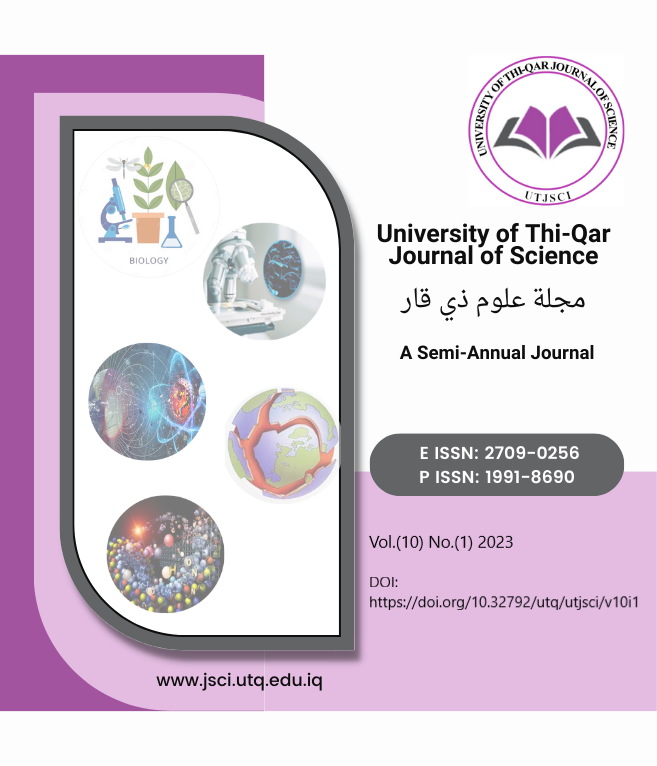Physiological Change of Interleukin-1 Alpha (IL-1α) in Iraqi, Thi-Qar Women with Polycystic Ovarian Syndrome
DOI:
https://doi.org/10.32792/utq/utjsci/v10i1.1058Keywords:
Interleukin-1Alpha (IL-1a), PCOS,, Pathophysiological detection, Thi-Qar womenAbstract
Background: A frequent and significant pro-inflammatory cytokine is IL-1α. In healthy cells, the IL-1α precursor is essentially present in almost all cell types, but it becomes a bioactive mediator upon necrotic cell death. IL-1α is also expressed by infiltrating myeloid cells within injured tissues. Aim and Objective: In this review, we focus on the biology of IL-1, its relationship to polycystic ovarian syndrome, and its developing role in the development and maintenance of the inflammatory processes that underlie the pathophysiology of PCOS women. Between the ages of (16 and 43), the 75 female patients enduring polycystic ovary syndrome are compared to the (50) healthy emales in the oversight group. IL- - alpha concentrations were noticeably greater in PCOS women compared to the control group, with p-values between (0.05-0.01)indicating a significant difference. These findings examined a non-significant difference in IL- levels between PCOS women and the control group, according to BMI. The research showed that PCOS women had considerably more IL-1 than women without PCOS in all BMI groups. IL-1-, however, in PCOS women and the Control Group The present findings looked at a non-significant variation in IL-1- concentration between PCOS women and the control group, according to Age. According to Age, the current results investigated at a non-significant difference in the concentration of IL-1- in PCOS women and the control group. When comparable age groups for women with (PCOS) and controls were examined, the results showed a significant rise in PCOS cases at p. value < 0.05.
References
H. F. Escobar-Morreale, “Polycystic ovary syndrome: Definition, aetiology, diagnosis and treatment,” Nat. Rev. Endocrinol., vol. 14, no. 5, pp. 270–284, 2018, doi: 10.1038/nrendo.2018.24.
S. B. A. M. . Sneha Latha T, Lakshmi Prasanna J, Jhansi Rani M, Divya K, “A review on natural remedies for prevailing polycystic ovarian disorder,” Am. J. Pharm. Res., vol. 5, no. 10, pp. 3307–15, 2015, doi: 10.1186/s13293-016-0073-y.
M. Ganaiem et al., “Effect of interleukin-1 receptor antagonist gene deletion on male mouse fertility,” Endocrinology, vol. 150, no. 1, pp. 295–303, 2009, doi: 10.1210/en.2008-0848.
H. F. Escobar-Morreale, M. Luque-Ramírez, and J. L. San Millán, “The molecular-genetic basis of functional hyperandrogenism and the polycystic ovary syndrome,” Endocr. Rev., vol. 26, no. 2, pp. 251–282, 2005, doi: 10.1210/er.2004-0004.
X. Ren, A. D. Gelinas, I. Von Carlowitz, N. Janjic, and A. M. Pyle, “Structural basis for IL-1α recognition by a modified DNA aptamer that specifically inhibits IL-1α signaling,” Nat. Commun., vol. 8, no. 1, pp. 1–13, 2017, doi: 10.1038/s41467-017-00864-2.
E. Voronov et al., “Unique versus redundant functions of IL-1α and IL-1β in the tumor microenvironment,” Front. Immunol., vol. 4, no. JUL, pp. 1–12, 2013, doi: 10.3389/fimmu.2013.00177.
A. Repaci, A. Gambineri, and R. Pasquali, “The role of low-grade inflammation in the polycystic ovary syndrome,” Mol. Cell. Endocrinol., vol. 335, no. 1, pp. 30–41, 2011, doi: 10.1016/j.mce.2010.08.002.
S. Shorakae, H. Teede, B. De Courten, G. Lambert, J. Boyle, and L. J. Moran, “The Emerging Role of Chronic Low-Grade Inflammation in the Pathophysiology of Polycystic Ovary Syndrome,” Semin. Reprod. Med., vol. 33, no. 4, pp. 257–269, 2015, doi: 10.1055/s-0035-1556568.
O. Farc and V. Cristea, “Pro-and Antitumor Role of the Interleukins 1 To 41,” Rom. Arch. Microbiol. Immunol., vol. 78, no. 3, pp. 149–162, 2019.
T. Artimani et al., “Evaluation of pro-oxidant-antioxidant balance (PAB) and its association with inflammatory cytokines in polycystic ovary syndrome (PCOS),” Gynecol. Endocrinol., vol. 34, no. 2, pp. 148–152, 2018, doi: 10.1080/09513590.2017.1371691.
M. Stȩpień, A. Stȩpień, R. N. Wlazeł, M. Paradowski, M. Banach, and J. Rysz, “Obesity indices and inflammatory markers in obese non-diabetic normo- and hypertensive patients: A comparative pilot study,” Lipids Health Dis., vol. 13, no. 1, pp. 10–13, 2014, doi: 10.1186/1476-511X-13-29.
K. M. Flegal, B. I. Graubard, D. F. Williamson, and M. H. Gail, “Underweight , Overweight , and Obesity,” vol. 293, no. 15, pp. 1861–1867, 2005.
Z. Bu, W. Dai, Y. Guo, Y. Su, J. Zhai, and Y. Sun, “Overweight and obesity adversely affect outcomes of assisted reproductive technologies in polycystic ovary syndrome patients,” Int. J. Clin. Exp. Med., vol. 6, no. 10, pp. 991–995, 2013.
S. Aboeldalyl, C. James, E. Seyam, E. M. Ibrahim, H. E. D. Shawki, and S. Amer, “The role of chronic inflammation in polycystic ovarian syndrome—a systematic review and meta-analysis,” Int. J. Mol. Sci., vol. 22, no. 5, pp. 1–31, 2021, doi: 10.3390/ijms22052734.
H. F. Escobar-Morreale, M. Luque-Ramírez, and F. González, “Circulating inflammatory markers in polycystic ovary syndrome: A systematic review and metaanalysis,” Fertil. Steril., vol. 95, no. 3, 2011, doi: 10.1016/j.fertnstert.2010.11.036.
J. N. Fain, “Release of inflammatory mediators by human adipose tissue is enhanced in obesity and primarily by the nonfat cells: A review,” Mediators Inflamm., vol. 2010, pp. 1–20, 2010, doi: 10.1155/2010/513948.
O. Osborn, H. Gram, E. P. Zorrilla, B. Conti, and T. Bartfai, “Insights into the roles of the inflammatory mediators IL-1, IL-18 and PGE2 in obesity and insulin resistance,” Swiss Med. Wkly., vol. 138, no. 45–46, pp. 665–673, 2008, doi: 10.4414/smw.2008.12276.
M. Olszanecka-Glinianowicz et al., “Is the polycystic ovary syndrome associated with chronic inflammation per se?,” Eur. J. Obstet. Gynecol. Reprod. Biol., vol. 133, no. 2, pp. 197–202, 2007, doi: 10.1016/j.ejogrb.2006.10.037.
Downloads
Published
License
Copyright (c) 2023 University of Thi-Qar Journal of Science

This work is licensed under a Creative Commons Attribution 4.0 International License.













